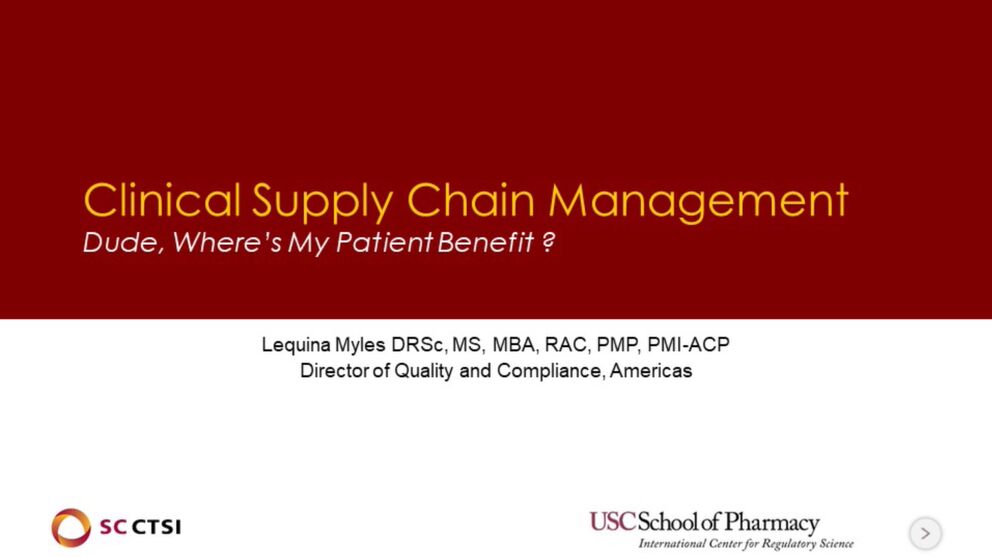- Disclaimer
- These slides are intended for educational purposes only and for the personal use of the audience.
- These slides are not intended for wider distribution outside the intended purpose without presenter approval.
- The content of this slide deck is accurate to the best of the presenter’s knowledge at the time of production.
- The views and opinions expressed in this presentation are those of the author and do not necessarily reflect the official policy or position of USC, Marken, or any affiliates of the author.
- Agenda: Overview of Clinical Supply Chain Management, Current Trends in Clinical Supply Chain, Challenges with Clinical Supply Chain, Lessons Learned in Clinical Supply Chain, Career Opportunities in Clinical Supply Chain
- What is Supply Chain Management?
- “Amazon Effect”: sponsors want the product delivered to patients in right time with the right specifications to meet the turnaround times for their targets
- Supply chain management (SCM) is active management of supply chain activities required to plan, control, and execute a product’s flow, from acquiring raw materials and production through distribution to the final customer
- Physical material flow
- Flow of information
- Financial transactions
- Pharmaceutical Supply Chain have multiple pathways
- Established process flow with bulk distribution
- Clinical Supply Chain Management is much more complex as it moves down the pathway from medical product to patients
- MFG, outbound from warehouse, collected by driver, routed on the airline, transported by airplane, truck, or sea, received by handler at port of entry, delivered to distributor, transport to the site, site coordinator, clinician, patient
- Personalized products can go over up to 120 handovers over the course of one month
- Other things to consider: material product, biological material, ancillary materials, packaging, documentation, cold chain management, data
- Supply chain management overlaps with healthcare and biopharma
- Medical Product: precision medicine, complex science
- Complex Trials: customized clinical trial design, global trials, decentralized trials
- Complex SCM: direct to patient/direct from patient, home health/home trial support
- Innovative Technology: interactive response technology, block chain, smart packaging, drones
- Specific clinical trials may be incompatible with the strict supply chain management chains of the involved parties; different geographies have different regulations, including the movement of product across state lines in the United States
- Sponsors in the clinical space are not well-versed on the regulations associated with the supply chain, especially in an international setting
- Sponsors have limited visibility to their product, especially in a clinical trial in which they need to maintain chain of custody from beginning to end
- COVID-19 clinical trials were a disruptor to supply chain management
- Over 1,500 clinical trials halted, causing limited access to sites
- Challenges: patient recruitment, protocol adherence, availability of supplies and raw materials (shortage from India and China), staff shortages, patient care, strained supply chain
- Lessons Learned from COVID-19
- Increased visibility to supply chain gaps and bottlenecks
- Contingency and business continuity
- Adaption and Innovation to Alternate Clinical Trial Models
- GCP, ICH E6 (R3)
- Collaboration among Industry Stakeholders
- Operation Warp Speed
- Career Outlook in Clinical Supply Chain Management
- Roles along the supply chain include information systems, warehousing, transportation, materials and procurement, sales, vendor management, customer service, quality, regulatory, operations, forecasting and planning, packaging and labelling
- Primary job responsibilities of the supply chain, based on the ACSM SCOR model:
- Plan (50%), Source (24.8%), Deliver (12.6%), Make (7.4%), Enable (4.9%), Return (0.3%)
- There has been growth in careers
- Over 3,000 jobs of Indeed, nearly 500 of which are based in California
- Positions range from Association up to Vice President
- e.g. CSC Associate, CSC Project Manager, Director/Senior Direction of CSC
- Job Requirements
- Bachelor's Degree
- Some years of experience with SCM
- Background can include Quality, Regulatory, Supply Chain and Business
- Global Business Acumen
- Familiarity with GMP, GCP, and GDP regulatory requirements
- Social/Cultural/Political Awareness
- Project management and change management
- Personality Traits: researcher, strategic thinker, agile, collaborator, problem solver, organized, proactive, negotiator, communicator, decomposer
- Median annual salary can range from $64,380 (purchasing agent) to $121,110 (purchasing manager), and potentially higher for executive positions
- The percent change in occupation growth projected between 2019-2029 is:
- Distribution Managers (6%), Operations Specialists/Managers (6%), Logistics Managers (4%), Purchasing Managers (3%), All Management Occupations (5%)
- Over 3,000 jobs of Indeed, nearly 500 of which are based in California
- Positions range from Association up to Vice President
- e.g. CSC Associate, CSC Project Manager, Director/Senior Direction of CSC
- Job Requirements
- Bachelor's Degree
- Some years of experience with SCM
- Background can include Quality, Regulatory, Supply Chain and Business
- Global Business Acumen
- Familiarity with GMP, GCP, and GDP regulatory requirements
- Social/Cultural/Political Awareness
- Project management and change management
- Personality Traits: researcher, strategic thinker, agile, collaborator, problem solver, organized, proactive, negotiator, communicator, decomposer
- Median annual salary can range from $64,380 (purchasing agent) to $121,110 (purchasing manager), and potentially higher for executive positions
- The percent change in occupation growth projected between 2019-2029 is:
- Distribution Managers (6%), Operations Specialists/Managers (6%), Logistics Managers (4%), Purchasing Managers (3%), All Management Occupations (5%)
- Positions range from Association up to Vice President
- Questions
- Lowering budget in clinical trials is most often coordinated by sponsor and service provider, which inherently includes the supply chain costs
- Supply chains are often considered “hidden costs”, as the logistics of product distribution often overlooked during clinical trial planning
- Conditioning the package is rarely considered in planning, and it is crucial to maintain the integrity of the product and avoid unnecessary delays
Regulatory Science Virtual Symposium: “Clinical Research Career Pathways” Session 3: Clinical Supply Chain Management: Dude, Where’s My Patient Benefit? (2021)
Regulatory & Quality Sciences
Leadership & Professionalism
Course Syllabus/Topics
Acknowledgement
Accompanying text created by Omer Baker, BS Human Biology Candidate | omerbake@usc.edu | Edited by Annie Ly, MS Regulatory Science Candidate | lyannie@usc.edu

